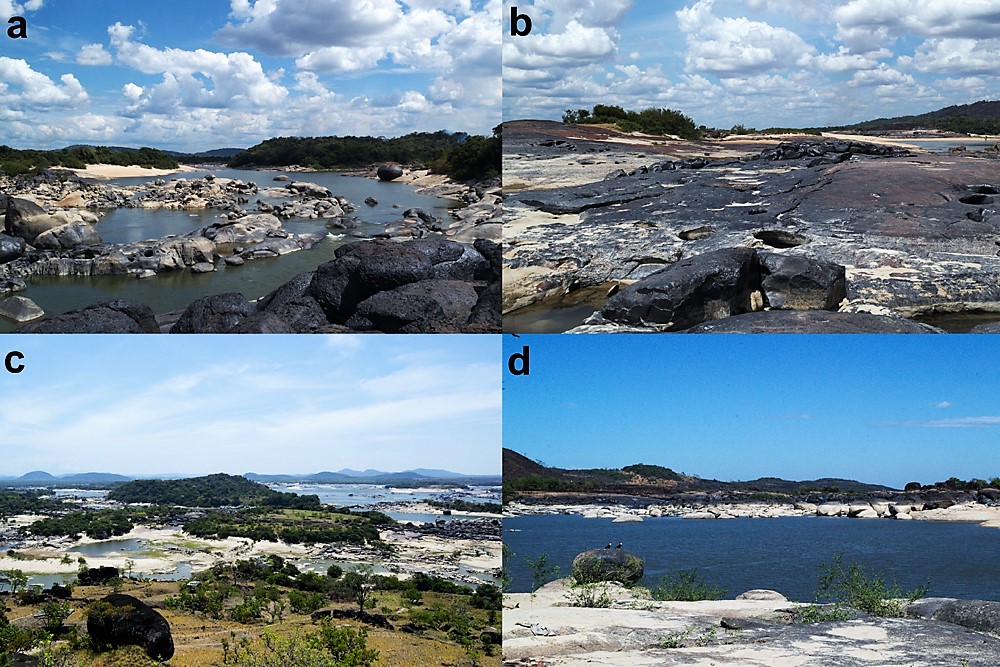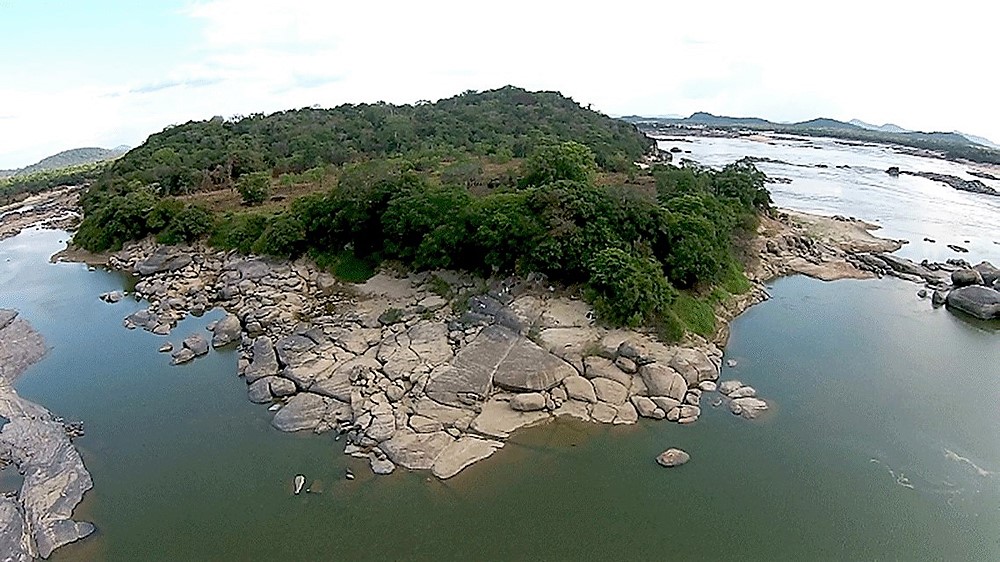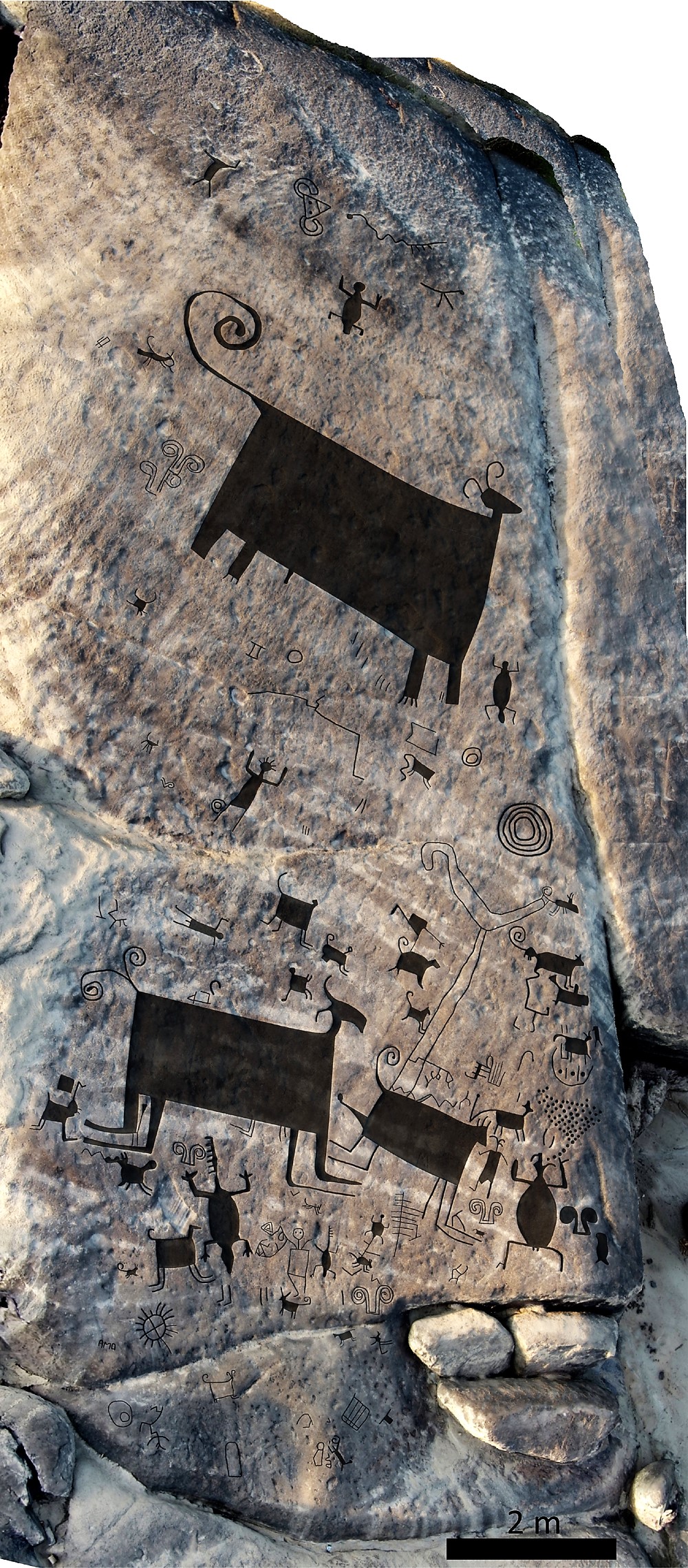


An article from University College London on phys.org - Venezuelan rock art mapped in unprecedented detail - reports on the rock engravings in western Venezuela. These rock art engravings are thought to be some of the largest recorded in the world. They have now been mapped in unprecedented detail by UCL researchers.

a) View of Raudal Wayuco and Picure (background), facing south; b) Raudal Yavariven looking west; c) overview of the Atures Rapids from mainland Venezuela (photograph by Jose Oliver); d) view from Picure looking north towards Cotua. Image: Dr Philip Riris.
The petroglyphs, some of which are thought to be up to 2,000 years old, include depictions of animals, humans and cultural rituals. One panel is over 300 square meters containing at least 93 individual engravings, the largest of which measure several metres across. Another engraving of a horned snake measures more than 30 metres in length.
The rock art surveyed is located in the Atures Rapids - Raudales de Atures - area of Amazonas state in Venezuela, historically reported as the home of the native Adoles by Jesuit priests. Eight groups of engraved rock art were recorded on five islands within the Rapids.
Drone technology was used to photograph the engravings, some of which are in highly inaccessible areas. Historically low water levels in the Orinoco River at the time the research was carried out also meant more of the engravings were exposed.

Image: University College London.
The paper's author Dr Philip Riris (UCL Institute of Archaeology) said: "The Rapids are an ethnic, linguistic and cultural convergence zone. The motifs documented here display similarities to several other rock art sites in the locality, as well as in Brazil, Colombia, and much further afield. This is one of the first in-depth studies to show the extent and depth of cultural connections to other areas of northern South America in pre-Columbian and Colonial times.

Top-down aerial perspective of east panel on Picure, with interpretative overlay of main engravings. North is at the bottom of the image. Image: Dr Philip Riris.
"While painted rock art is mainly associated with remote funerary sites, these engravings are embedded in the everyday - how people lived and travelled in the region, the importance of aquatic resources and the seasonal rhythmic rising and falling of the water. The size of some of the individual engravings is quite extraordinary."
Pre-Columbian art has a long history of study by naturalists and scientists travelling the Orinoco, such as Alexander von Humboldt, and has been the subject of archaeological research in the region for over half a century. Rock engravings of the Middle Orinoco River have been studied before, but never in this level of detail. The research therefore offers the opportunity for new insights into the archaeological and ethnographic context of the engravings.
Mapping of Venezuelan rock art by UCL researchers. Engravings thought to be some of largest recorded in the world https://t.co/eoC2v1zL6q #Amazonas #archaeology #petroglyphs pic.twitter.com/L3nLTPFcba
— Bradshaw Foundation (@BradshawFND) January 3, 2018
Aerial photograph of monumental Cerro Pintado petroglyphs with enhanced image overlay. Image: Dr Philip Riris.
In one panel surveyed, a motif of a flautist surrounded by other human figures probably depicts part of an indigenous rite of renewal. Performances conceivably coincided with the seasonal emergence of the engravings from the river just before the onset of the wet season, when the islands are more accessible and the harvest would take place.
The research is part of the Cotúa Island-Orinoco Reflexive Archaeology Project, funded by the Leverhulme Trust. Principal Investigator, Dr José Oliver (UCL Institute of Archaeology), said: "Our project focuses on the archaeology of Cotúa Island and its immediate vicinity of the Atures Rapids. Available archaeological evidence suggests that traders from diverse and distant regions interacted in this area over the course of two millennia before European colonization. The project's aim is to better understand these interactions. Mapping the rock engravings represents a major step towards an enhanced understanding of the role of the Orinoco River in mediating the formation of pre-Conquest social networks throughout northern South America."
by Bradshaw Foundation
Monday 03 February 2025
by Bradshaw Foundation
Friday 09 August 2024
by Bradshaw Foundation
Wednesday 24 July 2024
by Bradshaw Foundation
Thursday 04 July 2024
by Bradshaw Foundation
Monday 01 July 2024
by Bradshaw Foundation
Wednesday 20 March 2024
by Bradshaw Foundation
Tuesday 13 February 2024
by Bradshaw Foundation
Tuesday 13 February 2024
by Bradshaw Foundation
Thursday 01 February 2024
by Bradshaw Foundation
Tuesday 28 November 2023
by Bradshaw Foundation
Thursday 23 November 2023
by Bradshaw Foundation
Monday 20 November 2023
by Bradshaw Foundation
Tuesday 31 October 2023
by Bradshaw Foundation
Thursday 26 October 2023
by Bradshaw Foundation
Wednesday 20 September 2023
by Bradshaw Foundation
Monday 17 July 2023
by Bradshaw Foundation
Monday 03 February 2025
by Bradshaw Foundation
Friday 09 August 2024
by Bradshaw Foundation
Wednesday 24 July 2024
by Bradshaw Foundation
Thursday 04 July 2024
by Bradshaw Foundation
Monday 01 July 2024
by Bradshaw Foundation
Wednesday 20 March 2024
by Bradshaw Foundation
Tuesday 13 February 2024
by Bradshaw Foundation
Tuesday 13 February 2024
by Bradshaw Foundation
Thursday 01 February 2024
by Bradshaw Foundation
Tuesday 28 November 2023
by Bradshaw Foundation
Thursday 23 November 2023
by Bradshaw Foundation
Monday 20 November 2023
by Bradshaw Foundation
Tuesday 31 October 2023
by Bradshaw Foundation
Thursday 26 October 2023
by Bradshaw Foundation
Wednesday 20 September 2023
by Bradshaw Foundation
Monday 17 July 2023
Friend of the Foundation











